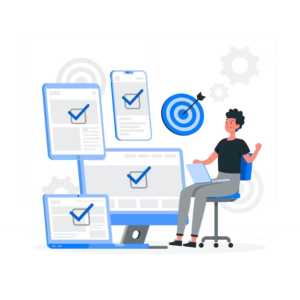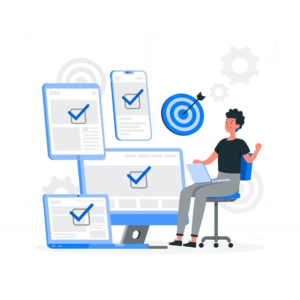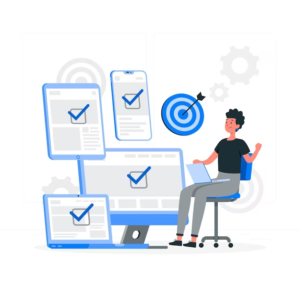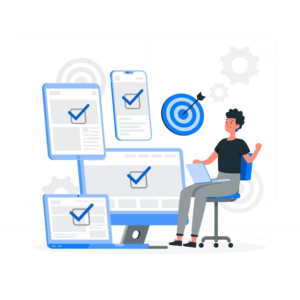In modern data management, understanding the flow and transformation of data is pivotal. Data lineage, depicting the journey of data from its origin to various transformations and consumption points, is crucial for data quality and governance. This article delves into data lineage tools, exploring their significance, types, and a curated list of the top 13 tools in this domain.
What Is Data Lineage?
Data lineage refers to the comprehensive trail that showcases the journey of data from its point of origin through various stages of processing, transformations, and eventual utilization across an organization’s data infrastructure. It acts as a roadmap, meticulously documenting how data moves and changes as it travels through different systems, applications, and processes within an organization. By providing a detailed narrative of data flow, lineage offers a deeper understanding of the data’s evolution, including its sources, transformations, and destinations.
This intricate depiction of data lineage serves as a fundamental pillar in ensuring data quality, integrity, and reliability. It allows organizations to trace and understand the life cycle of data, identifying potential bottlenecks, errors, or inconsistencies that may arise during its journey. Moreover, data lineage enables businesses to verify the accuracy and consistency of data, empowering informed decision-making by ensuring that data used for analysis or decision support is trustworthy and up-to-date.
Data lineage is a critical documentation tool that offers a clear and transparent view of data origins, dependencies, and transformations. It not only aids in troubleshooting data-related issues but also plays a vital role in compliance efforts, enabling organizations to meet regulatory requirements by providing a comprehensive understanding of how data is handled, processed, and utilized within the organizational framework.
Why Is Data Lineage Important?
Data lineage holds immense significance in the data-driven world for:
- Data Quality Assurance: Organizations can rectify errors and discrepancies by understanding data lineage, ensuring data accuracy and reliability.
- Regulatory Compliance: In regulated industries, data lineage is essential for demonstrating compliance by providing a transparent audit trail.
- Enhanced Decision-Making: A clear understanding of data lineage empowers organizations to make informed decisions based on reliable data.
What Are Data Lineage Tools?
Data lineage tools encompass specialized software designed to map, visualize, and manage the data lineage within an organization’s infrastructure. These tools offer functionalities to track data flow, establish relationships between datasets, and provide insights into data movement and transformations.
Types of Data Lineage Tools
- Metadata-Driven Lineage Tools: These tools rely on metadata to establish data lineage, extracting information from various sources to map data relationships and dependencies.
- Automated Discovery Tools: Utilizing automated processes, these tools discover and trace data lineage, often employing machine learning algorithms to infer lineage from data interactions.
- Hybrid Lineage Tools: Combining metadata-driven approaches with automated discovery offers a more comprehensive view of data lineage.
13 Best Data Lineage Tools
- Apache Atlas
- Informatica Enterprise Data Catalog
- Collibra
- Alation
- IBM InfoSphere Information Governance Catalog
- Waterline Data
- Talend Data Catalog
- Octopai
- erwin Data Intelligence
- Solidatus
- MANTA
- Unifi Software
- ASG Enterprise Data Intelligence
1. Apache Atlas
Apache Atlas, a key component within the Apache Software Foundation, is a comprehensive metadata management solution tailored for organizations seeking robust Data Lineage Tools. This platform empowers enterprises to efficiently capture, catalogue, and govern metadata from diverse data sources. One of its core strengths lies in its facilitation of data lineage, where Apache Atlas excels in establishing intricate relationships between disparate data assets. Through its functionalities, Apache Atlas offers a holistic perspective of data flow and dependencies, aiding in the visualization and management of complex data relationships within the organization’s ecosystem.
Key Features of Apache Atlas:
- Metadata-driven approach for establishing data lineage
- Centralized metadata repository for unified data management
- Integration capabilities with various data platforms and tools
- Customizable tagging and classification for efficient data governance
- Robust visualization features aiding in understanding complex data relationships
2. Informatica Enterprise Data Catalog
Informatica Enterprise Data Catalog emerges as a robust and comprehensive solution within Data Lineage Tools. This platform serves as both a data cataloging and data lineage tool, presenting a unified and comprehensive outlook on enterprise data assets. Users leverage its capabilities to seamlessly discover, comprehend, and govern various data sources dispersed across the organizational landscape. A fundamental strength of Informatica’s Data Catalog lies in its pivotal role in establishing and visualizing end-to-end data lineage. By offering detailed insights into data origins, transformations, and utilization patterns, it becomes instrumental in unravelling the intricate web of data flow and relationships within the organization.
Key Features of Informatica Enterprise Data Catalog:
- Automated metadata discovery and cataloging for comprehensive data lineage
- AI-driven data discovery and recommendations for improved data management
- Collaboration features facilitating data governance and collaboration among teams
- Integration capabilities with various data platforms and tools
- Impact analysis and data lineage visualization for better decision-making
3. Collibra
Collibra presents a holistic data governance platform, enriched with robust Data Lineage Tools integral to its offerings. This comprehensive solution equips organizations to comprehend, document, and visually represent data lineage intricacies embedded within multifaceted data landscapes. Collibra’s Data Governance suite empowers users by enabling the meticulous tracing of data flow. Through this, it ensures data quality assurance, adherence to compliance standards, and facilitation of well-informed decision-making processes.
Key Features of Collibra:
- Centralized data governance platform for comprehensive data lineage management
- Automated lineage mapping and visualization for enhanced insights
- Collaboration features enabling effective data governance practices
- Business glossary and metadata management for clear data understanding
- Workflow automation for streamlined governance processes
4. Alation
Alation stands out as an AI-powered data catalog, delivering an expansive perspective into an organization’s data assets, enhancing comprehension and optimising data usage. Robust Data Lineage Tools complement its emphasis on efficient data discovery and governance. These tools empower users to seamlessly monitor and trace data’s origins, transformations, and utilization patterns within the expansive data ecosystem, aligning with Alation’s broader objectives of fostering data understanding and governance.
Key Features of Alation:
- AI-powered data discovery and cataloging for efficient data lineage tracking
- Collaboration features fostering teamwork and data governance initiatives
- Data stewardship capabilities ensuring data quality and compliance
- Insights into data usage and popularity for better decision-making
- Integration with various data platforms and tools for seamless data management
5. IBM InfoSphere Information Governance Catalog
IBM InfoSphere Information Governance Catalog is a pivotal component within complex enterprise environments, functioning as an all-encompassing solution for managing metadata and establishing robust Data Lineage Tools. This platform equips users to seamlessly capture, comprehend, and govern metadata across diverse data sources. By providing detailed insights into data relationships, lineage structures, and usage patterns, IBM InfoSphere Information Governance Catalog becomes an essential asset for understanding and managing the intricate web of data flows within the enterprise.
Key Features of IBM InfoSphere Information Governance Catalog:
- Automated metadata discovery and cataloging for effective data lineage management
- Business glossary and metadata management for clear data understanding
- Impact analysis and visualization tools for comprehensive lineage insights
- Integration capabilities with various data platforms and tools
- Governance and compliance features ensuring data quality and regulatory adherence
6. Waterline Data
Waterline Data specializes in delivering a comprehensive data cataloging and governance platform to streamline data discovery and comprehension. Embedded within its suite are robust Data Lineage Tools, facilitating users in meticulously tracing data origins, transformations, and usage patterns. This comprehensive visibility offers an in-depth understanding of data flow dynamics spanning across the entire organizational landscape, empowering efficient data management and governance.
Key Features of Waterline Data:
- Automated data discovery and cataloging for efficient lineage tracking
- Data self-service features empower users to explore and utilize data effectively
- Metadata tagging and classification for enhanced data governance
- Integration capabilities with various data sources and tools
- Visualization tools for depicting complex data lineage structures
7. Talend Data Catalog
Talend Data Catalog emerges as a comprehensive solution catering to data cataloguing and metadata management needs within organizations. This versatile platform allows users to seamlessly discover, document, and govern data assets. At its core, Talend Data Catalog encompasses robust Data Lineage Tools, enabling users to track data origins and transformations proficiently. By facilitating detailed insights into the journey of data, this platform aids in establishing a clear understanding of data lineage, which is crucial for effective data management and governance.
Key Features of Talend Data Catalog:
- Automated metadata discovery and cataloging for establishing data lineage
- Collaborative features fostering effective data governance practices
- Data quality and profiling tools for ensuring data accuracy
- Integration capabilities with diverse data platforms and tools
- Visualization and impact analysis for enhanced lineage insights
8. Octopai
Octopai presents a comprehensive metadata management and Data Lineage Tools platform, delivering comprehensive visibility into the entirety of data flow within the organizational landscape. This platform optimises data discovery, metadata management, and lineage tracking. By providing end-to-end visibility, Octopai empowers users with a clear understanding of data movement and transformations, facilitating efficient data management strategies.
Key Features of Octopai:
- Automated metadata discovery for establishing comprehensive data lineage
- Impact analysis and change tracking for understanding data transformations
- Collaboration features facilitating effective data governance practices
- Integration capabilities with various data platforms and tools
- Visualization tools for simplified depiction of complex data lineage structures
9. Erwin Data Intelligence
Erwin Data Intelligence emerges as a stalwart solution encompassing robust data governance, metadata management, and advanced Data Lineage Tools capabilities. This comprehensive platform empowers users to efficiently capture, catalogue, and govern metadata originating from diverse data sources. Its exceptional strengths lie in visualizing and tracing data lineage across varied data sources, offering users intricate insights into the complex web of data relationships within the organizational landscape.
Key Features of Erwin Data Intelligence:
- Automated metadata discovery and cataloging for establishing end-to-end lineage
- Business glossary and metadata management for clear data understanding
- Impact analysis and visualization for comprehensive lineage insights
- Collaboration and workflow management for effective data governance
- Integration with various data platforms and tools for seamless data management
10. Solidatus
Solidatus provides a robust platform focusing on data lineage and metadata management, specifically engineered to map and visualize intricate data landscapes. This platform empowers users to model and document data flow, thereby gaining profound insights into the intricate relationships and dependencies within the data. Solidatus offers a comprehensive understanding of data relationships and dependencies, essential for efficient data management within complex organizational structures.
Key Features of Solidatus:
- Interactive visualization for depicting complex data lineage structures
- Collaborative features enabling teamwork and effective data governance
- Impact analysis tools for understanding data transformations
- Integration capabilities with diverse data sources and tools
- Metadata management functionalities for clear data understanding
11. MANTA
MANTA specializes in cutting-edge automated Data Lineage Tools, offering unparalleled visibility into complex data environments. This innovative platform excels in automating the tracking and visualization of data lineage, enabling users to comprehend data movement and transformations across diverse systems. MANTA’s proficiency lies in providing automated and comprehensive insights into data lineage, facilitating a deeper understanding of data flow and transformations within intricate data ecosystems.
Key Features of MANTA:
- Automated lineage tracking across diverse data sources and platforms
- Visualization tools for understanding complex data lineage structures
- Collaboration features for effective data governance initiatives
- Integration capabilities with various data tools and platforms
- Impact analysis for understanding data changes and transformations
12. Unifi Software
Unifi Software delivers a holistic data cataloging and governance platform, encompassing robust Data Lineage Tools. This solution empowers users by facilitating seamless discovery, cataloging, and tracing of data lineage. Unifi Software stands out in ensuring data accuracy and compliance by providing users with comprehensive capabilities to track and manage data lineage within the organizational landscape.
Key Features of Unifi Software:
- Automated data discovery and cataloging for establishing comprehensive lineage
- Collaboration and governance features for effective data management
- Metadata management functionalities for clear data understanding
- Integration capabilities with diverse data platforms and tools
- Visualization and impact analysis for enhanced lineage insights
13. ASG Enterprise Data Intelligence
ASG Enterprise Data Intelligence presents a robust data intelligence platform equipped with advanced Data Lineage Tools. This comprehensive solution empowers organizations by enabling efficient metadata capture, visualization, and governance. ASG Enterprise Data Intelligence stands out by establishing comprehensive data lineage, offering organizations meticulous insights into the intricate web of data relationships and dependencies within their data landscape.
Key Features of ASG Enterprise Data Intelligence:
- Automated metadata discovery and cataloguing for establishing comprehensive lineage
- Visualization and impact analysis for understanding data relationships
- Collaboration and workflow management for effective data governance
- Integration capabilities with diverse data platforms and tools
- Compliance and governance features ensuring data quality and regulatory adherence
How do you choose the best Data Lineage Tool?
Choosing the right data lineage tool involves several considerations:
- Functionalities: Ensure the tool aligns with your specific data lineage tracking needs.
- Scalability and Integration: Consider whether the tool can scale your organization’s growth and integrate seamlessly with existing data infrastructure.
- Ease of Use: Evaluate the tool’s user interface and ease of adoption for your team.
- Compliance and Security: Ensure the tool adheres to regulatory requirements and provides robust security measures.
- Vendor Support and Reputation: Research the vendor’s reputation, support, and future development plans for the tool.
Conclusion
In conclusion, data lineage tools are indispensable for organizations seeking to effectively manage, govern, and derive insights from their data. This article aimed to provide an overview of these tools’ significance and types and a glimpse into the top tools available, aiding organizations in making informed decisions for their data management strategies.



